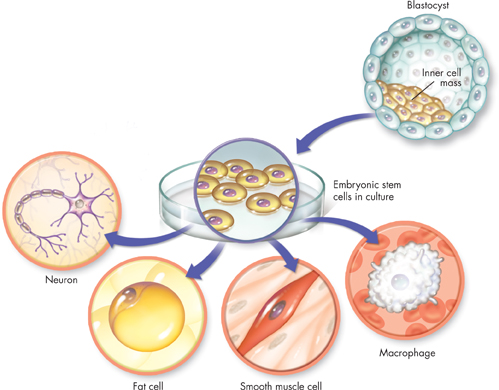Stem Cells  The unspecialized cells from which differentiated cells develop are known as stem cells. As the name implies, stem cells sit at the base of a branching “stem” of development from which different cell types form. Because of their potential to develop into other cell types, stem cells are the subject of intense interest by researchers around the world.
The unspecialized cells from which differentiated cells develop are known as stem cells. As the name implies, stem cells sit at the base of a branching “stem” of development from which different cell types form. Because of their potential to develop into other cell types, stem cells are the subject of intense interest by researchers around the world.
▸ Embryonic Stem Cells As you have seen, the pluripotent stem cells of the inner cell mass eventually produce all of the cells of the body. Embryonic stem cells are pluripotent cells found in the early embryo. In 1998, researchers at the University of Wisconsin found a way to grow these embryonic stem cells in culture. Their experiments confirmed that such cells did indeed have the capacity to produce just about any cell type in the human body. In fact, scientists have managed to coax mouse embryonic stem cells to differentiate into nerve cells, muscle cells, and even into sperm and egg cells. Recently, sperm made from embryonic stem cells were used to generate live mice.
▸ Adult Stem Cells For years, biologists have suspected that adult organisms might also contain some types of stem cells. Cells in the blood and skin, for example, have a limited life span and must be constantly replaced. This suggests that the body contains pools of stem cells from which new skin and blood cells can be produced.
Adult stem cells are groups of cells that differentiate to renew and replace cells in the adult body. Because of their more limited potential, adult stem cells are referred to as multipotent (muhl TIP uh tunt), meaning that they can develop into many types of differentiated cells. Typically, stem cells of a given organ or tissue produce only the types of cells that are unique to that tissue. For example, adult stem cells in the bone marrow can develop into several different types of blood cells, while stem cells in the brain can produce neurons, or nerve cells.

FIGURE 10–20 Embryonic Stem Cells After fertilization, the human embryo develops into a hollow ball of cells known as a blastocyst. The actual body of the embryo develops from the inner cell mass, a cluster of cells inside the blastocyst. Because of their ability to differentiate into each of the body's many cell types, these cells are known as embryonic stem cells.
dTable of Contents
- Formulas and Equations
- Applying Formulas and Equations
- Mean, Median, and Mode
- Estimation
- Using Measurements in Calculations
- Effects of Measurement Errors
- Accuracy
- Precision
- Comparing Accuracy and Precision
- Significant Figures
- Calculating With Significant Figures
- Scientific Notation
- Calculating With Scientific Notation
- Dimensional Analysis
- Applying Dimensional Analysis




